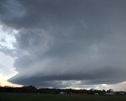Late in 2008, SPRI updated ANSI/SPRI RP-4, "Wind Design Standard for Ballasted Single-ply Roofing Systems." The updated edition builds on the standard's 1988 and 2002 editions and includes two significant changes.
ANSI/SPRI RP-4-08
The differences between the 2008 edition and the standard's previous editions are the addition of a definition for the term ballast and revision of the description for surface exposure categories that are used with the standard's design tables.
Also, the following statement has been added: "The Design Tables are based on the premise that the ballast will not blow off the roof at the design rooftop wind speeds."
Design method
Using ANSI/SPRI RP-4, a project designer first should determine the basic wind speed and surface exposure category based on a building's location. The standard's Attachment II provides a basic wind speed map of the U.S., and Section 2.10 provides detailed descriptions of Surface Exposures B, C and D.
Next, the building's height, edge (parapet) height and Importance Factor should be determined. The standard provides prescribed methods for determining building and parapet heights. Section 2.17 provides guidance for determining a building's Importance Factor.
Then, using the building's basic wind speed, building and parapet heights, and surface exposure category, the appropriate system design (1, 2 or 3) can be determined using the standard's design tables. For aggregate-ballasted single-ply membrane roof systems, the standard defines System 1 as using No. 4-sized (3/4- to 1 1/2- inch nominal) aggregate; System 2 as using No. 4-sized aggregate in the field and No. 2-sized (1 1/2- to 2 1/2-inch nominal) aggregate in the perimeter and corners; and System 3 as using No. 2-sized aggregate in the field and an adhered roof system in the perimeter and corners.
Once the system design is determined, Section 5—Design Provisions needs to be consulted for enhancements necessary to the system design. Specific enhancements are provided for large wall openings; positive interior building pressures; rooftop projections; overhangs, eaves and canopies; Surface Exposure D; and Importance Factor Categories III or IV.
As an example, for buildings located in Surface Exposure D or fitting Importance Factor Category III or IV, the standard stipulates for the purpose of using the design tables, the rooftop wind speed should be increased 20 mph from the basic wind speed specified in the wind map.
Code adoption
ANSI/SPRI RP-4 is referenced in the International Building Code (IBC) as a requirement for ballasted single-ply membrane roof systems. ANSI/SPRI RP-4's 1998 edition is referenced in IBC's 2000 and 2003 editions, and ANSI/SPRI RP-4's 2003 edition is referenced in IBC's 2006 and 2009 editions.
ANSI/SPRI RP-4's 2008 edition has not yet been incorporated into IBC because the code's three-year publication schedule does not coincide with ANSI's five-year standards cycle.
In addition to requiring ballasted single-ply membrane roof systems to comply with ANSI/SPRI RP-4, IBC's 2006 and 2009 editions restrict the use of rooftop aggregate surfacings in hurricane-prone regions and certain building height and exposure category situations. In some situations, the code's restrictions regarding the use of aggregate rooftop surfacings are more stringent than ANSI/SPRI RP-4. (For additional information, see "What will happen to aggregate?" August 2004 issue, page 61).
When considering aggregate-ballasted single-ply membrane roof systems, it is important to consider the applicable version of ANSI/SPRI RP-4 and any additional limitations the code may place on the use of aggregate surfacings.
Mark S. Graham is NRCA's associate executive director of technical services.



